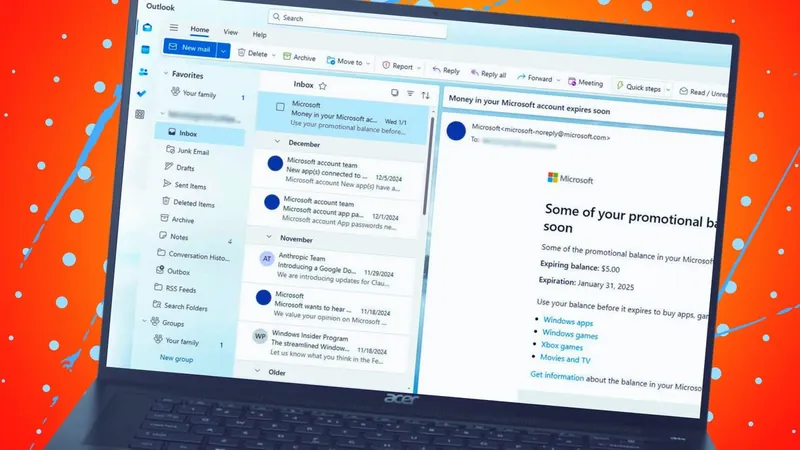
Microsoft's Controversial Move: New Outlook App to Launch on Windows 10 Without Opt-Out Options!
2025-01-13
Author: Wei
Introduction
Microsoft is making headlines once again, but this time with a decision that could leave many Windows 10 users feeling frustrated. The tech giant has announced that its brand new Outlook app will be forcibly installed on Windows 10 systems, whether users wish to embrace it or not.
Details of the New Outlook App
In a recent communiqué sent to Microsoft 365 subscribers through the Microsoft 365 Admin Center, Microsoft confirmed that the new Outlook will come pre-installed on Windows 10 devices starting with the optional release on January 28, 2025, accompanied by the security update on February 11, 2025. This means users will soon find themselves with little choice regarding their email and calendar management.
Replacement of Existing Apps
The most notable change? The new Outlook will completely replace the existing Mail and Calendar apps. Even if users try to access the old Mail and Calendar through their Start menu shortcuts, they will automatically be redirected to the new app. However, users can take solace in the fact that the classic Outlook version included in Microsoft 365 or Office 365 will remain available for now — but for how long?
Microsoft's Assurance
Microsoft has reassured users that, while the new Outlook will be an installed application on their devices and can be found in the Start Menu, the classic Outlook will coexist alongside it for the time being. This dual availability seems to be a temporary measure before Microsoft pushes towards a singular solution.
User Control Post-Installation
Here’s the catch: While you can’t stop the new Outlook from being installed, there is an option to remove it after installation. Microsoft has provided a support page outlining the steps needed to hide or uninstall the new app, giving users some autonomy within their organization or personal use.
Transition Strategy
This action is part of a broader strategy to transition users to the new Outlook experience, having started testing the updated software in 2022 and rolling it out to businesses in 2024. Interestingly, the new Outlook has already been preinstalled on new devices running Windows 11 and those updated with the 23H2 build.
Purpose of the Change
Why is Microsoft making this change? The new Outlook is designed to unify the various features and settings from the Mail and Calendar applications into a streamlined single program. Microsoft aims to standardize not just the interface across their desktop, mobile, and web platforms but also improve the overall user experience. However, this ambitious goal has come under fire from many users.
User Criticism
Critics have been vocal about the new Outlook’s perceived shortcomings, noting that it lacks features present in the original Mail and Calendar apps. Users have expressed that the design feels less like a traditional Windows application and more akin to a simplistic webpage running on their PC. Many who have tested the new Outlook share similar sentiments, criticizing it for what they label as poor design and limited functionality.
Future of Classic Outlook
But the controversy doesn’t stop there. In a blog post from March 2024, Microsoft hinted at a forthcoming "cutover stage" where new installations of Outlook through Microsoft 365 would eventually phase out the classic version entirely. This raises alarms as users face the reality that the option to revert back to classic Outlook might soon vanish. While Microsoft claims that classic Outlook will be supported until at least 2029, many users are left wondering if their beloved email client will be retired sooner.
Conclusion
As a longtime fan of the classic Outlook, the idea of replacing it with a more simplified new version is concerning. Although classic Outlook is packed with features that may be overwhelming for some, it has proven to be a robust email client for many users. Unless Microsoft can dramatically enhance the new Outlook to match its predecessor's capabilities, the prospect of saying goodbye to classic Outlook feels premature and disheartening.
Final Thoughts
Are you ready for the change? Or are you among the disgruntled users yearning for the rich capabilities of classic Outlook? The clock is ticking, and the future of your Windows email experience is about to shift dramatically!


 Brasil (PT)
Brasil (PT)
 Canada (EN)
Canada (EN)
 Chile (ES)
Chile (ES)
 Česko (CS)
Česko (CS)
 대한민국 (KO)
대한민국 (KO)
 España (ES)
España (ES)
 France (FR)
France (FR)
 Hong Kong (EN)
Hong Kong (EN)
 Italia (IT)
Italia (IT)
 日本 (JA)
日本 (JA)
 Magyarország (HU)
Magyarország (HU)
 Norge (NO)
Norge (NO)
 Polska (PL)
Polska (PL)
 Schweiz (DE)
Schweiz (DE)
 Singapore (EN)
Singapore (EN)
 Sverige (SV)
Sverige (SV)
 Suomi (FI)
Suomi (FI)
 Türkiye (TR)
Türkiye (TR)